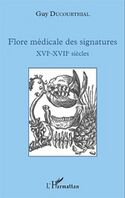News 2016 November
Books

Peony signals through the red color of its flowers that it possesses hemostatic properties, and walnuts, the meat of which can easily evoque a brain, indicate by this particularity their vertue to calm headaches. At least this is stressed by the authors who wrote treatises on the Theory of signatures applied to plants.
The history and content of the Medical Flora based on this Theory of signatures had not been the object of an in-depth study up to now, although it is frequently evoqued in books of botany, biology, medicine, pharmacy, and even philosophy. The Flore médicale des signatures aims to fill this gap.
Such a theory doesn't go back to Antiquity, although the first Greek and Latin authors who wrote books about plants never failed to observe that the color or the morphology of many plants did evoque sometimes parts of the human body or various external manifestations of diseases. They sometimes translated the accuracy of their observations by giving some plants names evoquing such analogies, but they never attempted to find causes.
Paracelsus, a somewhat original and provocative Swiss physician, was the first, in the 16th century, to give the basis of the Theory of signatures and to propose its applications. According to him and his followers, the similarity between the color, the morphology or the biology of many plants with parts of the human body or various external manifestations of diseases should in no case be due to pure chance. They consider that such analogies are particular signs which have to be interpreted as signatures that God, in His great compassion for Mankind, would have applied on precise plants, in order to informe man discretely of the therapeutic vertues they contain. The Theory of signatures had thus originally the aim to act as a precious guide to search for medicinal plants and their properties, to which physicians were asked to refer before prescribing their remedies. It was nevertheless largement opposed since the 17th century and totally abandoned during the Enlightment, being then only evoqued in some litterary texts praising the beauties and secrets of Nature.
In this Flore médicale des signatures, you will find both a history of the elaboration of the theory of signatures in plants and a presentation of its content through the main texts - generally translated here for the first time in French - not only of Paracelsus himself, but also of authors often forgotten, such as D. Sennert, J. P. Rhumelius, H. C. Agrippa, O. Crollius and above all G. B. della Porta, who exposed the theory with a great conviction. The book also encompasses a detailed inventory of the many plants which compose this very particular flora.
Guy Ducourthial is Docteur ès Sciences of the Muséum National d'Histoire Naturelle (Paris). Geographer and ethnobotanist, he particularly dedicated his researches to some aspects of the History of Botany, poorly studied up to now. He is the author of a Flore magique et astrologique de l'Antiquité, of La Botanique selon Jean-Jacques Rousseau and of a Petite Flore mythologique.
Guy Ducourthial, 2016. Flore médicale des signatures XVIe - XVIIe siècles. (in French). Paris, L'Harmattan, 672 p. ISBN : 978-2-343-09472-4. price : 52 €.
17 November 2016